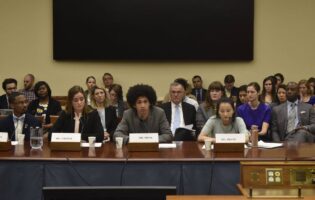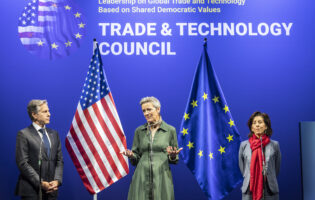The Decentralization of the Electricity Grid – Mitigating Risk in the Energy Sector

Kirsten Verclas
ORISE Science and Technology Policy Fellow
Kirsten Verclas is an ORISE Science and Technology Policy Fellow. Previously, she was a Program Manager in the International Department of the National Association of Regulatory Utility Commissioners (NARUC) working on regulatory partnerships in Africa under a NARUC-U.S. Agency for International Development (USAID) Cooperative Agreement. Before coming to NARUC, Ms. Verclas was a Senior Program Manager at the American Institute for Contemporary German Studies (AICGS) at Johns Hopkins University, where she managed the Institute’s grant projects. She initially joined AICGS as Executive Assistant in 2003 and started working in the Institute’s Research Program in 2008. Ms. Verclas has written extensively on energy and climate as well as security policy in the transatlantic context. She holds a BA in International Relations with a Minor in Economics from Franklin and Marshall College and an MA in International Relations with a concentration in Security Studies from The Elliott School at The George Washington University. She also earned an MS in Energy Policy and Climate from Johns Hopkins University in August 2013.
She is a 2017-2018 participant in AICGS’ project “A German-American Dialogue of the Next Generation: Global Responsibility, Joint Engagement,” sponsored by the Transatlantik-Programm der Bundesrepublik Deutschland aus Mitteln des European Recovery Program (ERP) des Bundesministeriums für Wirtschaft und Energie (BMWi).
Introduction
Natural disasters like Hurricane Katrina in the U.S. in 2005 and the earthquake off the coast of Japan in 2011 (which resulted in a devastating tsunami and the nuclear accident in Fukushima) have profound effects on the electricity grid. In a 2009 report, the U.S. Department of Energy stated that Hurricane Katrina caused approximately 2.7 million customers to lose power and that it took four to eight weeks to restore electricity to all but the worst affected households in the Gulf region. Additionally, the storm caused Entergy New Orleans to file for bankruptcy as it simultaneously faced restoration costs and large loss of revenues.[1] Japan’s earthquake and tsunami severely damaged the energy sector of the country. In addition to the disabled nuclear plant Fukushima Daiichi, many other nuclear plants in Japan were shut down due to safety concerns, resulting in nearly 65 percent of the country’s nuclear energy being off-line in the summer of 2011.[2] Rolling black outs resulted, especially in Tokyo. In the U.S., even smaller ice and snow storms in the winter or thunderstorms in the summer impair the electricity grid and routinely cause power outages in impacted regions.
In addition to natural disasters, September 11, 2001 has also increased the fear of a terror attack on the electricity grid. When a blackout caused over 50 million customers to lose power in large parts of the Northeast, including New York City, in August 2003, many initially suspected a terrorist attack. While the cause was eventually determined as an increase in power demand that led to an overload of the power lines and consequent failure of the power system, analysts have predicted that terrorist attacks could cause similar or more intense outages. Protecting the electricity grid from terrorist attacks is “ ‘both a hardware and a software issue,’ because hackers can use viruses to make industrial control programs go haywire and damage critical equipment such as transformers.”[3] This makes the protection of the grid a dual challenge. The Stuxnet computer virus, which affected Siemens software used primarily in nuclear power plants, was a recent example of a virus impacting the electricity grid.
Industrial countries like the U.S., Japan, and Germany depend on a functioning electricity grid as the backbone of their economies and way of life. Impediments to the electricity grid not only harm the economy and hurt the bottom line; they can also cause loss of life and hamper a country’s ability to react to a large-scale catastrophe. Decentralized energy schemes such as microgrids and distributed energy generation can play an important role for developed countries in mitigating risk and security threats to the electricity sector and ensuring continuous electricity delivery even in times of natural disasters or terrorist attacks.
The Current Situation in Germany and the U.S.
The U.S. and Germany both have a more or less centralized energy grid. The U.S. has three independently synchronized grids: the Eastern Interconnection, the Western Interconnection, and Electric Reliability Council of Texas.[4] Germany has four electricity sub-grids, which are all interconnected in one German-wide grid.
Analysts cite regulatory hurdles, the financing of a grid overhaul, and the current state of technological advancement as the main obstacles to implementing decentralized electricity in the U.S. and elsewhere.[5] To advance the research and development of microgrids and distributed energy generation, the U.S. federal government has made $4.5 billion available under the American Recovery and Investment Act of 2009 to fund pilot projects. One of these projects is being implemented by General Electric (GE) at the largest Marine base in the U.S.: Twenty-nine Palms Base in California. Military installations have been at the forefront of the development of microgrids in the U.S. as “more intelligent energy management system can help military bases further safeguard the operation of their power systems while also reducing overall energy cost.”[6] Additionally, universities have become increasingly interested in microgrids: “campus microgrids, and especially educational institutions, are currently the leading segment of the microgrid market in terms of actual online operating capacity.”[7] Yet, apart from pilot projects, the U.S. has not attempted to make serious investments in microgrids and as the funds provided by the stimulus money have been allocated, future funding of similar initiatives remains uncertain.
In Germany, last year’s decision by the government to phase out nuclear energy by 2022 heralded the country’s overall energy transformation (Energiewende) and makes the decentralization of Germany’s energy grid even more urgent. The large German utilities that operate Germany’s nuclear plants would like to see the renewable energy production centralized. Ambitious projects that envision large amounts of energy generated by photovoltaic (PV) cells in North Africa and transmitted to Europe as well as big wind parks on the German coast are being discussed. Yet, all of these projects would require building many more transition lines, increasing costs and implementation time. Additionally, and in this context more importantly, Germany’s energy sources would be increasingly vulnerable as it has to rely on energy generated outside of the country or transmission lines that could be subject to outages by natural disasters or terrorist attacks. Analysts like Professor Dr. Volker Quaschnig from the Technical University Berlin argue that a decentralized grid would be more cost effective and would allow the energy transition to be completed at a faster speed.[8] As Germany grapples with how to implement its decision to phase out nuclear energy, the question of continuing with a centralized electricity grid or the option to focus on more distributed electricity generation will become central to its energy policy.
The Benefits of Decentralized Energy Grid from a Risk Perspective
Overshadowing any discussions on electricity grids is the new buzzword in the U.S. and Germany: the smart grid. The Electric Power Research Institute (EPRI) defines a smart grid as a “electricity delivery system [that] monitors, protects, and automatically optimizes the operation of its interconnected elements—from the central and distributed generator to the high voltage transmission network and the distribution system, to industrial users and building automation systems, to energy storage installations, and to end-use consumers, and their thermostats, electric vehicles, appliances, and other household devices.”[9] While the development of smart grids is necessary to modernize the electricity market and integrate renewable energy as much as possible, focusing on smart grids alone will not mitigate the risk associated with a centralized electricity sector. In fact, it is the combination of decentralized energy generation and smart microgrids that will make electricity grids more environmentally sustainable and less vulnerable to security risks.
A decentralized electricity grid has many environmental and security benefits. Microgrids in combination with distributed energy generation provide a system of small power generation and storage systems, which are located in a community or in individual houses. These small power generators produce on average about 10 kW (for individual homes) to 2 MW (for communities) of electricity. While connected to and able to feed excess energy into the grid, these generators are simultaneously independent from the grid in that they can provide power even when power from the main grid is not available.
Safety benefits from a decentralized grid are immense, as it has build-in redundancies. These redundancies are needed should the main grid become inoperable due to a natural disaster or terrorist attack. Communities or individual houses can then rely on microgrids with distributed electricity generation for their power supply. Furthermore, having less centralized electricity generation and fewer main critical transmission lines reduces targets for terrorist attacks and natural disasters. Fewer people would then be impacted by subsequent power outages. Additionally, “decentralized power reduces the obstacles to disaster recovery by allowing the focus to shift first to critical infrastructure and then to flow outward to less integrated outlets.”[10] Thus critical facilities such as hospitals or police stations would be the first to have electricity restored, while non-essential infrastructure would have energy restored at a later date. Power outages are not only dangerous for critical infrastructure, they also cost money to business and the economy overall. EPRI “reported that power outages and quality disturbances cost American businesses $119 billion per year.”[11]
Decentralized grids are also more energy efficient than centralized electricity grids because “as electricity streams through a power line a small fraction of it is lost to various factors. The longer the distance the greater the loss.”[12] Savings that are realized by having shorter transmission lines could be used to install the renewable energy sources close to homes and communities. The decrease of transmission costs and the increase in efficiency would cause lower electricity usage overall. A decrease in the need to generate electricity would also increase energy security—fewer imports of energy would be needed. The U.S. especially has been concerned with energy dependence in the last decades; decentralized electricity generation could be one of the policies to address this issue.
The Way to a Decentralized Energy Grid
Integrating renewable energy sources in the current electricity grid does not necessarily mean that the energy grid is automatically decentralized. Current plans in Germany for large, centralized renewable energy generation such as wind parks or large PV installations underline this. Additionally, the introduction of software technology needed for smart grids might make the sector even more vulnerable to cyber attacks. The transition from a centralized to a decentralized electricity grid will be cost-intensive as new infrastructure will have to be developed and built. Yet, the security and environmental benefits outweigh the risks and costs of a decentralized electricity grids. However, policymakers have to address the financial, regulatory, and technological issues that are currently impeding the realization of decentralized energy grids.
In terms of technology, two important issues will have to be solved for decentralized electricity grids to become a reality: Energy storage and transmission lines that allow electricity to flow in both directions. As electricity is produced through photovoltaic and wind energy close to communities and individual homes, it will become necessary to store the produced energy, especially because renewable energy is an intermittent energy source. Transmission lines that withdraw as well as feed electricity into the larger grid are already available but would have to be implemented more widely for decentralized electricity to become feasible. Ideas to store electricity in electric vehicles or local batteries are also being researched and discussed. As technological advancements are made it is important that the risk and security implications for these technologies are rigorously assessed.
Policymakers therefore have to ensure that the policy framework addresses these issues. This becomes most imminent concerning the regulation of smart grids. As smart grids become more and more integral to the electricity grid, questions of cyber security and vulnerability to cyber attacks by terrorist or criminals become more urgent. The U.S. National Institute of Standards and Technology, tasked by the U.S. Congress, has released preliminary “Guidelines for Smart Grid Cyber Security in 2010,” but the U.S. Government Accountability Office found in a report that these guidelines do not address some of the possible threats, such as the possibility of a combined cyber-physical attack.[13] Cyber security in general, and pertaining to the smart grid in particular, is also hampered by the fact it falls under the prerogative of many U.S. departments and agencies, so the regulatory approach can be fractured and uncoordinated. In Germany, privacy issues also complicated the introduction of smart grids, as citizens are worried about data collection and retention.
Regulations and financial support are needed by lawmakers on both sides of the Atlantic to further research and technology in the development of a decentralized energy grid. Regularity and legal frameworks provide companies with clear guidance on how to operate in new and uncharted territory such as smart and microgrids. Additional funding will allow companies and government entities such as the military to continue to invest in smart and microgrids to become the catalyst for decentralized electricity grids across the country. Thus, it is imperative for Germany and the U.S. to continue to provide financial and policy support in this area critical to national security, which includes mitigating any new risks that might develop from new technologies. Yet, even though technological, financial, and regulatory impediments remain, a decentralized electricity grid is important for both countries’ environments and safety.
Kirsten Verclas is the Senior Program Manager at AGI.
[1] “Comparing the Impacts of the 2005 and 2008 Hurricanes on U.S. Energy Infrastructure,” U.S. Department of Energy, February 2009, http://www.oe.netl.doe.gov/docs/HurricaneComp0508r2.pdf, (26 April 2012).
[2] Craig Dale, “Energy Angst: Japan’s Post-Tsunami Power Crisis,” CBC News, 30 May 2011, http://www.cbc.ca/news/canada/story/2011/05/27/f-japan-energy-angst.html (24 April 2012).
[3] Brian Wingfield, “Power-Grid Cyber Attack Seen Leaving Millions in Dark for Months,” Bloomberg News, 1 February 2012, http://www.bloomberg.com/news/2012-02-01/cyber-attack-on-u-s-power-grid-seen-leaving-millions-in-dark-for-months.html (24 April 2012).
[4] “The Future of the Electricity Grid,” Massachusetts Institute of Technology, 2011, http://web.mit.edu/mitei/research/studies/documents/electric-grid-2011/Electric_Grid_Full_Report.pdf (23 April 201).
[5] Guy Warner, “Decentralized Power and Disaster Preparation,” 12 April 2011, http://www.greentechmedia.com/articles/read/decentralized-power-and-disaster-preparation/(26 April 2012).
[6] “GE to Build Microgrid Demo at CA Marine Base,” SustainableBusiness.com News, 9 July 2009, http://www.sustainablebusiness.com/index.cfm/go/news.display/id/18533 (26 April 2012).
[7] “Expanding Interest in Microgrids, US is best market,” SustainableBusiness.com News, 1 September 2011, http://www.sustainablebusiness.com/index.cfm/go/news.display/id/22855 (26 April 2012).
[8]Volker Quaschnig, “The Future of Photovoltaics in Germany,” 8 February 2012, http://www.cic-invest.de/fileadmin/media/Downloads/Future_of_Photovoltaics_in_Germany.pdf (25 April 2012).
[9] Paul L. Joskow, “Creating a Smarter U.S. Electricity Grid,” Discussion Draft, 1 October 2011, http://economics.mit.edu/files/7427 (25 April 2012).
[10] Guy Warner, “Decentralized Power and Disaster Preparation,” 12 April 2011, http://www.greentechmedia.com/articles/read/decentralized-power-and-disaster-preparation/ (26 April 2012).
[11] Virginia Tech Consortium on Energy Restructuring, Distributed Generation Educational Model, “Chapter 1.3: Benefits of Distributed Generation,” 2007, http://www.dg.history.vt.edu/ch1/benefits.html (26 April 2012).
[12] Osha Gray Davidson, “Why We Need a ‘Local Energy’ Movement,” Mother Jones, 2 November 2009, http://motherjones.com/blue-marble/2009/11/why-we-need-local-energy-movement (26 April 2012).
[13] “Electricity Grid Modernization,” United States Government Accountability Office, January 2011, http://www.ferc.gov/industries/electric/indus-act/smart-grid/gao-report.pdf (23 April 2012).








